#Theories of Literature and Culture
Explore tagged Tumblr posts
Text
"The shift from the Afro-Caribbean zombie to the U.S. zombie is clear: in Caribbean folklore, people are scared of becoming zombies, whereas in U.S. narratives people are scared of zombies. This shift is significant because it maps the movement from the zombie as victim (Caribbean) to the zombie as an aggressive and terrifying monster who consumes human flesh (U.S.). In Haitian folklore, for instance, zombies do not physically threaten people; rather, the threat comes from the voduon practice whereby the sorcerer (master) subjugates the individual by robbing the victim of free will, language and cognition. The zombie is enslaved."
— Justin D. Edwards, "Mapping Tropical Gothic in the Americas" in Tropical Gothic in Literature and Culture.
Follow Diary of a Philosopher for more quotes!
19K notes
·
View notes
Text
I get so annoyed when people shit talk Lindsey Lohan calling her ugly or saying that plastic surgery ruined her etc. My God let her live, as a radical feminist I'm naturally and obviously against plastic surgery but have some sympathy. She was exploited by the film industry since she was a child, was an addict and had a series of dangerous events for her and people around her that made her go to jail.
Let Lindsay in peace for the love of god.
#radblr#radfeminism#radical feminism#radical feminists do interact#radical feminists do touch#radical feminst#radical feminist literature#radical feminist theory#radfemsafe#radical feminist community#radical feminist safe#radical feminists please interact#radical feminists please touch#plastic surgery#anti plastic surgery#anti beauty industry#anti beauty culture#anti beauty standards#terfsafe
69 notes
·
View notes
Text
Every single person on the admissions committees for my dream med schools will roll their eyes when I say I want to become a doctor bc I love science and also love the humanity of it all……… but it’s literally the truth
#Like idk what else id even major in in theory except maybe literature or global politics#Or maybe id become an engineer like my mom but i rly doubt it#This makes sm sense for me#Like I think my X factor has a lot to do w the intersection of medicine and politics / my cultural background but still#At the end of the day I j love science but want to actually apply it to something#I could def see myself being a PhD in another life tho#Being an MD PhD would be so crazy but why am I tempted to look into it#Someone tranquilize her
52 notes
·
View notes
Text
in I hate it here, taylor says, 'like you are a poet trapped inside the body of a finance guy' and guess who was working in an insurance company but wanted to be a writer and spent all his life writing and considered one of the greatest of all time... Franz Kafka and he hated his life. Most of his works are fusion of reality with fantasy. his choice of words, his literary style, his main characters, all contain a sense of romanticism and then taylor says, 'i'll save all my romanticism for my inner life and i'll get lost on purpose' his major stories depicts how he wanted to move to another place, where he is seen, and taylor says, 'i hate it here so i will go to lunar valleys in my mind'
#taylor swift#this is just my theory and i had to share it#taylor swift you are a genius#i am just relating my fav writer and my fav singer#ttpd#this just blew my mind#the tortured poets department#the tortured poets society#franz kafka#ttpd era#ttpd the anthology#ttpd i hate it here#swifties#taylornation#taylorswift#literature#i hate it here#kafkaesque#kafka#swifties culture#taylor nation#the eras tour
42 notes
·
View notes
Text

The Melancholic Woman: Eva Hesse, Ennead (1965), and Trauma, De-strung


(source: ICA Boston)
I will open this essay with a line from art historian, Anne M. Wagner’s essay, Another Hesse, on her journal October, vol. 69 – wherein she writes of our subject, American sculptor Eva Hesse:
Hesse’s self-scrutiny, we learn once again, is a means of coping with “environment” – with the inheritance of the past. But it is also the measure – even the proud badge – of her “difference”, the difference, we remember, of being an artist. (p. 131)
Anne M. Wagner’s essay on Eva Hesse will be one of the main sources of this paper.
Here, we will be able to trace Eva Hesse’s art and its asymbolia to the artist’s melancholia and her journey of sublimation and working through. We will also thereby arrive at more questions to ponder Hesse’s life, and inquire about the connections among art, melancholia, and the semiotic – and possibly ponder a perspective that ties the end-goal of these Kristevan concepts together.
(Before I go on, I just wanna say that this essay may draw on similarities EVA HESSE: POST-MINIMALISM INTO SUBLIME, by Robert Pincus-Witten. I wrote this specific essay more than a year ago for my Cultural, Literary, and Critical Theory class, and I only found this essay just today, as I am writing and doing more research for this piece. LOL. However, I would like to justify that the content of my essay is to draw connections between Hesse’s art and Kristeva’s psychoanalytic theory. I did enjoy Witten’s essay, though!)

(Source: pbs.org)
Eva Hesse
At the height of Nazi Germany, Hesse’s family fled to America for protection from religious persecution, but it was not long until sanctuary proved to be fickle as well, in the land of the free. Due to trauma implicated by the Second World War that vehemently caused the deaths of Hesse’s extended family, the serious circumstances of (Eva Hesse’s mother) Ruth Marcus House’s bipolar disorder worsened. These events dominoed to Wilhelm Hesse’s divorce from Ruth Marcus, and Ruth’s suicide. Adding salt to the wound, Wilhelm would marry a woman named Eva. Upon the new marriage, the young girl and her step-mother would share the same name.
Identity crisis aggravated young Eva’s trauma – from the persecution of family whose faces she had never known, to losing her to suicidal mother at ten. It seemed like grief was her very being.
Graduating from Yale, she exhibited works whose style displayed that of Abstract Expressionism and paved the way for Minimalism.
Art historians speculate how these traumas were sublimated into her art. Her self-portraits showcase distorted images of faces and figures. They are almost like a child’s attempt at creating a figure painting, except that their tone is so somber that only an adult can express such a feeling.

(Untitled, 1965, oil on canvas: From: mutualart.com)
However, the most intriguing work of Hesse does not come from two-dimensions – but three. This includes Hesse’s sculpture, Ennead (1965).


(Ennead, 1965, oil on canvas. From: icaboston.org)
Eva Hesse’s Ennead (1965)
All that there is to the piece: acrylic, paper mache, some resin-coated strings, plywood, some plastic, and a title possibly referencing the Egyptian pantheon.
The Institute of Contemporary Art, Boston, describes the artwork as such:
The orderly, formulaic application of the threads devolves into an increasingly chaotic composition as they accumulate and tangle toward the floor. A few strands are affixed to the adjacent wall, cordoning off a wedge of space that becomes part of the sculpture itself. This gesture also draws the viewer’s attention to the corner of the gallery, activating this normally overlooked area. Additional material hangs to touch the floor, thus uniting three planes. “Ennead” means a group of nine, in this case referring to the nine points from which the strings extend.
How can we interpret art whose surface presence is devoid of any points from its meaning? Baroque art can be so interpreted by its gargantuan number of details that fit on a four-cornered canvas. Poetry can be dissected among its metaphors, language, and enjambments. How can we possibly describe a sculpture so bare of material and overly abstract in its form? Was it meant to be this way – stripped down and bare?
Asymbolia and Melancholia
Many of Hesse’s works portray a distinct use of asymbolia, and the stimulation of asymbolia to its audience.
It is impossible to speak of Ennead without speaking about Hesse – primarily because Hesse and her art are one. Hesse even says: “My life and art have not been separated. They have been together.”
Ennead is no exception – however, with absolutely little to no “initial and final'' interpretation of meaning when you see the sculpture. What can we then say about Eva Hesse through the piece? Even art historians themselves, up to this day, consider Ennead to be an enigma on its own – its minimalism minimizes itself, to the point of devoiding any meaning, making us doubt if there is any at all.
First, we must discuss the asymbolia in Ennead – the art itself. Though by instinct and intuition, the substance of Ennead is uninhabited on its own, I would like to shed a few pointers on the piece and its asymbolia through its deliberate absurdity.
The strings were meant to be orderly at first, until its tail-end, wherein Hesse describes them as a jungle. Hesse even took in the effort to dye the strings to possibly add more aesthetic depth to them. Hesse describes the process of this piece in one of her journals.
The further it went toward the ground, the more chaotic it got; the further you got from the structure, the more it varied. I've always opposed content to form or just form to form. (Quoted in L. R. Lippard, op. cit., p. 62)
However, even when Hesse describes her decision to irrationalize the hinds of the strings, the art still talks gravel to the path towards the most inane question: What does it mean?
So, we shall secondly address the audience’s confusion, that stems from the asymbolia of the audience themselves – the very inability to attach any familiarity or meaning to the symbols the art presents, because of the very fact that it lacks anything.
The only thing that makes sense of Hesse’s art is nonsense – the asymbolia found in Hesse’s art, that stems from dissecting, stripping down, and representing her trauma. Hesse states in one of her interviews: “There is no abstract art. You must always start with something… A painter paints to unload himself of feelings and vision.”
Must her own “something” be from her depression – from the trauma of losing her mother, identity, and other factors throughout?
We take the theory behind this inquiry from Julia Kristeva’s illustration of asymbolia and melancholia in her book, Black Sun – “The negation of that fundamental loss opens up the realm of signs for us, but the mourning is often incomplete. Melancholia then ends up in asymbolia, in loss of meaning…” (p.42).
Hence, to study the bare Ennead is to study Hesse’s bare melancholia.
We may never have the opportunity to bear witness to Hesse’s trauma, as only she and herself can live it, so we turn to her journals,
Throughout her life, Hesse seems to be on good terms with working through with her depression, as she sublimates it with her art – if it means going against the conventions imposed on her by four-cornered dimensions of papers and canvases, and the one-platform norm of past sculptures (Ennead takes up two adjacent walls, and thereby two dimensions).
Asymbolia and the neglect of the pre-conceived semiotic can be seen in her journals – which instead of letters and intelligible words, consist of drawings that penetrate any dividers and lines.
Kristeva furthermore explains this psychoanalytic mechanism as she illustrates the control of the preverbal in aesthetic creation: “When the struggle between imaginary creation (art, literature) and depression is carried out precisely on that frontier of the symbolic and the biological we see indeed that the narrative or the argument is ruled by primary processes” (p.65) – explaining the subnormality of Hesse’s art and entries, and how the manifestations of obscurity stem from the mere struggle of Hesse’s melancholia.

(Figure 3: Hesse’s journal. From: sugarcandymtn.com)
Other than these, her excerpts write of her own feelings of depression and anxiety: “I must write, my sanity is involved. I cry and cry, the pages are wet. I have no one, to go to and the edge of hysteria and insanity is not far apart” (October 19, 1964).
Anne M. Wagner writes: “Anyone who wants to make a serious contribution to remembering Hesse will likewise have to speak about a wound. For what is striking about Hesse’s art is its utter inwardness, with artistic languages of the day: her imagery and effects are not learned by rote, only to be parroted back more or less unchanged” (p. 159)
With this: Must her melancholia still be the root of her asymbolic art? Or was this art a testament to her ability to self-scrutinize all along? Furthermore, will there be anything to self-scrutinize when there is no trauma?
Conclusion: The Futile Point of Interpretation
Hesse intended her work to be autobiographical, but never understood – and thus reflecting the paradox of identity: to know, but never understand. Even her journals were not meant for the purpose of understanding: “Hesse’s journals and their users have meant that it is no longer possible for viewers “not to know the artist” – or at least, not to feel they know her, and to prepare themselves accordingly when looking at her art.”
Yet, even when we have read Hesse’s journals, watched documentaries, and studied countless journals from art historians – the impossibility to fully understand still looms over her audience. So then we ask the question: What should we feel to know of Hesse? The illness caused by both personal and socio-economic circumstances of her time? Must her works be cursed with the fallacy of perpetually being tied to her trauma.
On Dostoevsky, Kristeva writes: “Works of art thus lead us to establish relations with ourselves and others that are less destructive, more soothing.” Hesse’s artifacts are therefore not records of her mania, but documentations of her survival from it. Her illness, therefore, is not what should be reflected of her life – but her sisyphean triumph over it.
Maybe it is for the better – as the point of art itself is to sublimate the traumatic aggression of the artist, and (like a monster) to never let it out of the cage of the canvas. Kristeva can even attest to this, saying: “Art seems to point to a few devices that bypass complacency and, without simply turning mourning into mania, secure for the artist the connoisseur a sublimatory hold over the lost Thing” (p. 97)
Hesse did this concealment well, so much so that it is said the artist herself might not have realized this. As Wagner would write: “If Hesse’s life did enter her art, it did so by a process that Hesse herself was in a position to describe. We would be looking for ways (Hesse’s unconscious) repeatedly configured. I think such imagery exists in Hesse’s art, and I take it to concern the artist’s feelings toward her mother above all” (p. 165) So much so, that even daring to question the trauma behind Hesse’s art, we do not only turn a blind eye to the artist herself, but arrive at a futile destination when we do: “Yet, in asking them [questions on Hesse’s art] we risk losing sight of the workings of Hesse’s unconscious – a notion that, after all, was the motivating impulse of this discussion. But the artist and her unconscious are not far away.” (p. 173)
Conclusion
I will close with another one of Wagner’s concluding lines:
“To claim that Hesse’s art aims to remember and express a common human quality or experience is not the same as attributing to it some universal force or purpose. It gives its own account of that experience.” (p. 186)
This aim of art is reminiscent to how beauty sublimates melancholia in the form of art, much like giving its own account of an experience. Kristeva writes:
“Beauty emerges as the admirable face of loss, transforming it in order to make it live. Melancholia to the point of becoming interested in the life of signs, beauty may also grab hold of us to bear witness for someone who grandly discovered the royal way through which humanity transcends the grief of being apart.”
(p. 100)
Hesse’s journey as an artist is proof that asymbolia – another result of melancholia – paves the way into sublimation. Art is therefore not rooted in the melancholic, its her way of forging a path deeper underneath it. Art is agency from the trial of inner-disagency. Art is therefore the artist’s most individual and subjective struggle, not of her depression, but one of working through. Precisely through this art, we unlock the beauty sculpted from the marble of melancholia. Hesse and Ennead are just among the myriad of melancholic beauty in the realm of art.
SOURCES
Kristeva Julia. Black Sun : Depression and Melancholia. Columbia University Press 1989. https://archive.org/details/blacksun00juli. Accessed 27 Feb. 2023.
Artincontext. “Eva Hesse - The Brief Life and Incredible Works of Eva Hesse the Artist.” Artincontext.org, 4 Apr. 2022, https://artincontext.org/eva-hesse/.
Branaman, Bianca. “Love - Eva Hesse.” Sugar Candy Mountain, Sugar Candy Mountain, 4 Sept. 2018, https://sugarcandymtn.com/blogs/the-brand/love-eva-hesse.
“Ennead.” EVA HESSE, https://www.christies.com/en/lot/lot-315751.
“Ennead.” Institute of Contemporary Art, Boston, https://www.icaboston.org/art/eva-hesse/ennead.
Evemy, Benjamin Blake, et al. “Auctions, Exhibitions & Analysis for +500K Artists.” MutualArt, MutualArt, 17 Feb. 2023, https://www.mutualart.com/.
“The Sickness of Being Disallowed: Premonition and Insight in the 'Artist's Sketchbook'.” O A R, https://www.oarplatform.com/sickness-disallowed-premonition-insight-artists-sketchbook/.
#antiquities#literary theory#psychoanalysis#literature#art#history#art history#art criticism#art critique#fine art#museum studies#postmodernism#modernism#julia kristeva#sigmund freud#culture#society#culturalheritage#eva hesse#female artists#female artwork#trauma#abstract#post minimalism#minimalism#minimalist art#post minimalist art
7 notes
·
View notes
Text
In providing a dream language of meritocracy ("get the body you deserve"; "a gorgeous figure doesn't come without effort"), entrepreneurial spirit ("make the most of your natural assets"), absolute personal liability for body size and aging ("you can totally reshape your body"; "your facial lines are now within your control"), and even open admissions ("at last you too can know the secret beautiful women have kept for years"), they keep women consuming their advertisers' products in pursuit of the total personal transformation in status that the consumer society offers men in the form of money. On one hand, the aspirational promise of women's magazines that they can do it all on their own is appealing to women who until recently were told they could do nothing on their own. On the other, as sociologist Ruth Sidel points out, the American Dream ultimately protects the status quo: "It discourages those at the bottom from developing a viable political and economic analysis of the American system [substitute: the beauty myth], instead promoting a blame-the-victim mentality ... a belief that if only the individual worked harder, tried harder, he [she] would 'make it.'" But the myth of entrepreneurial beauty, of woman against nature, hurts women in the same way as the original model hurts men—by leaving out the words "all else being equal."
The Beauty Myth: How Images of Beauty Are Used Against Women, by Naomi Wolf
#the beauty myth#naomi wolf#beauty culture#radblr#radfem#radical feminism#radical feminist safe#radical feminists do interact#radical feminists do touch#radical feminists please touch#feminism#feminist literature#radical feminists please interact#radical feminist literature#radical feminst#radical feminist theory#radical feminist community#radfem theory#misogyny#patriarchy
5 notes
·
View notes
Text
As an early modernist, it's always bizarre to see so much writing advice along the lines of "I just wish more writers read broadly enough to understand the fundamental distinctiveness of original characters and story lines in fiction writing, the thing that separates true literature from all other forms of fiction writing..."
I mean, I wish people read broadly enough to understand that the value for originality as the foremost defining quality of publishable fiction is bound up in deeply modern assumptions driven by capitalism and intellectual property law, but none of us get everything we want, I guess!
...But seriously, even if you restrict yourself to English-language literature, please read some fiction written prior to 1700 before forming arguments about the fundamental nature of fictional literature through all of time and space. You don't get Shakespeare's Troilus and Cressida without Chaucer's Troilus and Criseyde, and you don't get Chaucer's Criseyde without Boccaccio's.
This isn't simply loose inspiration in the way that all things have inspirations, but active engagement with a very specific character and plot none of them had invented. Chaucer's version of Criseyde in particular is very much in dialogue with other iterations of her, and the sympathy and nuance he brings to the character really rewards familiarity with the Cressida figure as usually depicted—a familiarity he could, at the time, expect his audience to have.
That kind of intertextuality was extremely normalized at the time as a general rule, not only when it came to specific works or authors, and would be so for centuries afterwards. In fact, fiction writing involving pre-existing characters and plots was a common element of fiction written in English for far longer than capitalism has existed. We are still closer in time to when Shakespeare was writing Troilus and Cressida than he was to the medieval source of the story.
#the idea that originality of character and plot is the distinctive quality of (fictional) literature as a genre is - well.#it's one thing in pragmatic terms since we /do/ live in a world where publishing is enormously affected by ip and capitalism#but the way pragmatic realities are then integrated into theories of how art fundamentally operates without accounting for cultural norms?#it's very strange—especially in the context of lecturing people for not reading outside their wheelhouse#obviously not everyone is going to become an early modernist but some baseline acknowledgment of the effect of capitalism on literary norms#does not seem too much to ask from people making sweeping arguments about the nature of fiction writing as a medium#isabel talks#academic chatter#literature#artist: geoffrey chaucer#text: troilus and criseyde#artist: william shakespeare#text: troilus and cressida#artist: giovanni boccaccio#text: il filostrato#early modern chatter
3 notes
·
View notes
Text
I'm having such a galaxy brained moment right now that I'm honestly too overwhelmed and exhausted to properly explain my thoughts.
But anyway, Doki Doki Literature Club at its core is a game about loneliness and the ungodly psychological horrors it can create. And how even in the darkest of days, when we can feel the void of space itself stare at us and like all hope is lost... how incredibly important the smallest little loving things people can do are, and strive to give that same love to others and ourselves unconditionally.
#ddlc#doki doki monika#doki doki yuri#doki doki natsuki#doki doki sayori#doki doki literature club#there's a LOT more to that claim#and maybe that was already obvious to everyone else or something#idk but regardless i never thought about it before and i thought it was interesting#i also have a lot of thoughts about things like ddlc+ and the kind of fucked up media literacy culture game theory has created...#but that's a discussion for another day#moo tag#moo posts#moothebloo
47 notes
·
View notes
Text


The Ethics of Ambiguity by Simone de Beauvoir (Translated from the French by Bernard Frechtman). First English-language edition published by Philosophical Library in 1948.
•
#Quotes & extracts#Simone de Beauvoir#Literature & writers#Philosophy#Existentialism#Humanism#Feminism#‘The Ethics of Ambiguity’ book by Simone de Beauvoir#Political theory & action#Human rights#Nurturing empathy & democratic culture#Ethics#Quest for freedom#Wikipedia
5 notes
·
View notes
Text
sometimes I get the urge to just try different classes in other academic programs but then it will make me never finish my bachelor's degree orz
#I've already done this before I don't need to extend it longer... (already planning on an extra semester to the 4 years)#but like material culture or like literature and critical theory and women and gender studies :///#for context I've already taken some courses for fun: Japanese lit and a linguistics course#kat's asides
2 notes
·
View notes
Text
“ ‘All cruel people describe themselves as paragons of frankness,’ a Tennessee Williams character once proclaimed. My own experience testifies to something of the same. I go down to the bookstore and skim shiny new memoir jacket after shiny new memoir jacket, until my mind starts to blur with blurb-speak testifying to each writer’s brutal honesty, which is usually a clouse cousin of his or her ‘searing’ or ‘unsentimental’ prose, which, to be truly praiseworthy and dazzling, must also somehow shimmer onto the page ‘without a drop of self pity.’ I wander out of the bookstore wondering, Is honesty paired with brutality a more winning, or at least a more marketable, combination? And why has self-pity become the specter to be avoided at all costs, in order to earn artistic seriousness, moral rectitude, and perhaps, that all-important commodity, readers?”
--Maggie Nelson, The Art of Cruelty, 2011
16 notes
·
View notes
Text
Beyond Survival: Music, Cybertext, and Paratext in “The Last of Us. A Three-Part Series In a world teetering on the brink of collapse, Less than a decade ago, you might have envisioned the iconic voice of Don LaFontaine echoing in your mind upon reading such an introduction. Now, as these realities seem inevitable, we’ve lost our sense of what’s purely fictional. The Last of Us” emerges not…
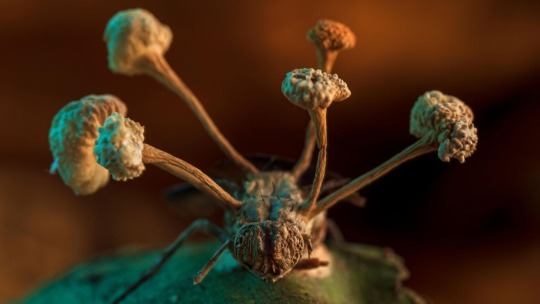
View On WordPress
#character development#cybertext#digital narrative#emotional storytelling#ergodic literature#fan culture#Game criticism#game design#game soundtracks#Game Theory#gaming culture#Gustavo Santaolalla#HBO adaptation#immersive gameplay#interactive fiction#Interactive storytelling#Ludology#media adaptation#moral choices#narrative analysis#narrative storytelling#paratext#participatory media#Player Agency#post-apocalyptic#survival themes#the last of us#transmedia storytelling#video game analysis#video games
2 notes
·
View notes
Text


i'm still on lolita, damn this book is hard to read. every page i literally have a discomfort on the way he speaks about lolita. it's so sickening! but the writing is so good, i don't even know what to say. *Fiodora thinks so too!


on the other hand i'm gonna start 'pop song' and 'a peste' today! it's gonna be i guess my forth or fifth camus. i love him sm. also, i need to finish it soon cause my uni library doesn't accept us to keep the books on vacation and semester is ending. soooo... 🤸🏻♀️
it's nice day today, very cloudy. i love it, it puts me in a great mood! 🤍🌧
#cultural theory#literary#book journal#bookworm#currently reading#writing#booklr#books and reading#tbr#literature#lolita#pop song#albert camus#camus#the plague#vladimir nabokov
13 notes
·
View notes
Text
re: "litfic" vs YA discourse, one thing i think it's important to remember is that, despite everything, what we consider to be "litfic" tends to sell MUCH LESS than YA does and publishing is, ultimately, a business whose primary reason for existence is to sell books.
people can complain about exclusivity in the "literary establishment" (whatever that even means these days) but, ultimately, that "literary establishment" actually has very little power in comparison to the power of marketers and the suits behind the scenes in these publishing companies who decide what they think will sell the most amount of copies with the least amount of effort on their end
#tbh i think that is one of the reasons for the ''push'' to YA#bc content that is ''safe'' and not likely to offend is easier to sell to a wider variety of demographics (in theory)#writing#literature#capitalism#purity culture#text
5 notes
·
View notes
Text

Trajectories and Movements of Filipino People: Diasporic Objects and Possibilities for Rematriation, Marian Pastor Roces (Alliance Français Manila, September 7, 2024)
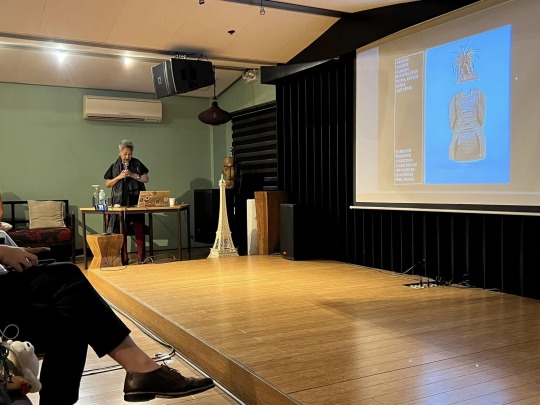
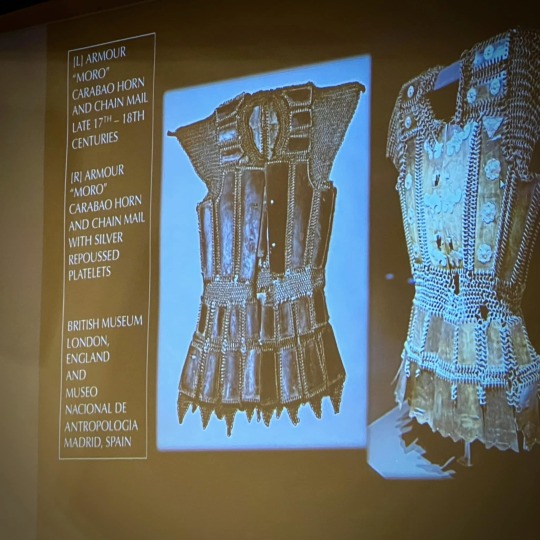
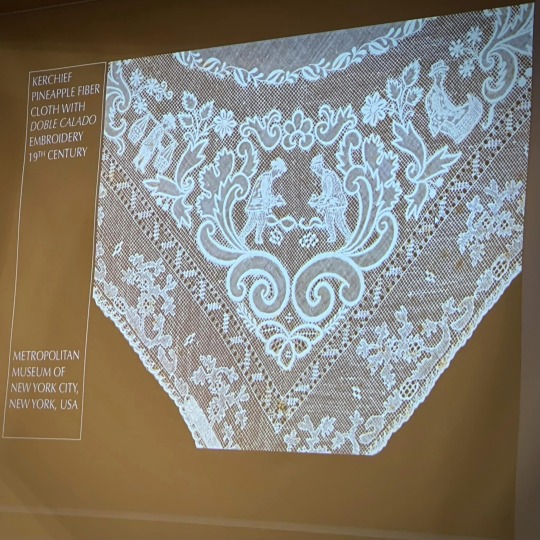
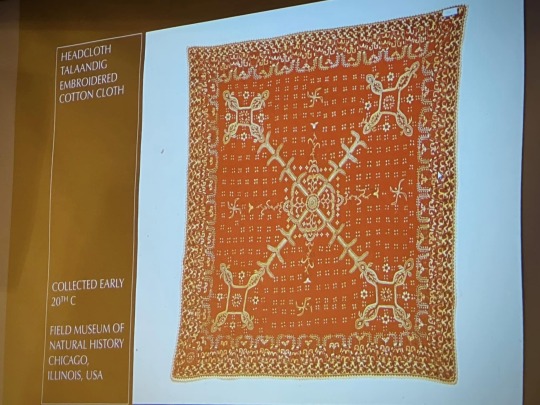
(Photos from Tara Illenberger, Facebook. We attended the same talk, though I was not able to take much photos as much, since I was not seated at the front. 😅)
Would like to start this post by saying that it was such an honor to have met Marian Pastor Roces again. For my would-be followers who are yet to read my blog posts, especially those who are situated abroad, I would like to introduce Marian Pastor Roces to you. MPR is an art critic, museum curator (and creator, in a comical sense), writer, political analyst, and cultural critic. She has hosted the establishments of numerous cultural initiatives that concern cultural heritage of ethnic groups in the Philippines. She is also a writer of essays and books, and an editor for Mapping Philippine Material Culture — a global archive of the different diasporic Filipino art and antiquities.
I met her the first time when I hosted a talk for her at my university. Terrific woman. I wish I had learned about her way sooner, from when I was a kid. Then, I would not have been so indecisive of what I wanted to be when I grew up and knew that I wanted to be a cultural heritage lawyer from the start, haha!
Something this talk proved further was the very principle that
cultural objects have memory too,
much like how much of the movements of Filipino people are reflected in the movements of its cultural objects.
Click read more to read the notes I got from the talk! ⬇️
There were three events that mark as significant events and turning points in the movements of the Filipino people.
Austronesian Migration: Wherein a seaborne migration set sail from the island of Taiwan to Batanes, in Northernmost Philippines. Objects traced and left behind by our Austronesian ancestors revealed marks of cultural connections along their trail.
1887 Madrid Exposition: Wherein maltreatment from the colonial Spaniards sought to display people of the Igorots in Human Zoos. The Filipino people have become an object themselves according to the colonizer.
Philippine Diaspora and Globalization: Wherein Filipino artifacts are now dispersed in cultural and archival institutions globally. Now, the material culture heritage of the Philippines is in large measure overseas. Filipinos do not have access to much of the material evidence of our heritage. Among the outcomes of this unknowing is an abyssmal loss of measures of quality that Philippine Peoples enjoyed until about a century ago.
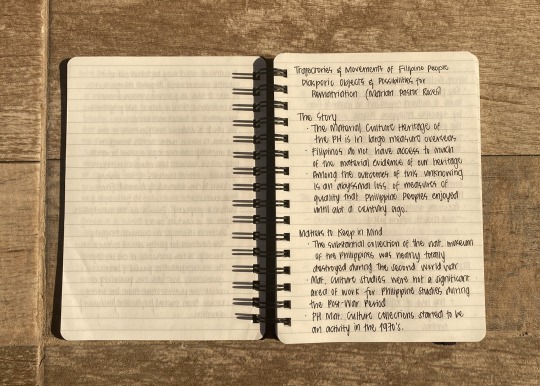
The substantial collection of the National Museum of the Philippines was nearly totally destroyed during the Second World War, the same event which led to the adopted of the 1954 Hague Convention, briefly discussed in the previous post.
Material Culture Studies were not a significant area of work for Philippine Studies during the Post-War Period.
Philippine Material Culture collections started to be an activity in the 1970's.
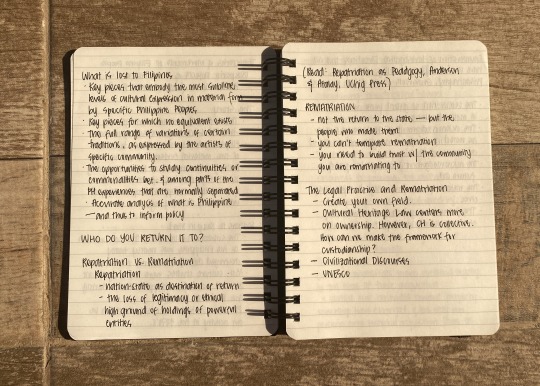
What is lost to the Filipinos, as diasporic objects are detached from them?
Key pieces that embody the most ✨ sublime ✨ levels of cultural expression in material form by specific Philippine Peoples. Here, Marian does not refer to these pieces by the quantity of cultural objects being produced, but by the quality of it. You can get traditional, authentic fabric anywhere in the region where the community resides — but all the ones that were made special, limited, and ceremonious are all stored in museums abroad.
Key pieces for which no equivalent exists.
The full range of variations of certain traditions, as expressed by the artists of specific community.
The opportunities to study continuities or commonalities between and among parts of the Philippine experiences that are normally separated.
Accurate analysis of what is Philippine — and thus to inform policy.

WHO DO YOU RETURN THE OBJECTS TO? Repatriation vs. Rematriation
Repatriation:
Nation-state as destination of return.
The loss of legitimacy or ethical high ground of holdings of powerful entities.
Rematriation:
Not return to the state — but the people who made them.
Though legal processes are able to create a process for repatriation, you cannot template rematriation.
You need to built trust with the community you are rematriating to.
The Legal Practice and Rematriation:
Cultural Heritage law centers more on private/institutional ownership (i.e. cultural property). However, Cultural Heritage is inherently collective. Hence, what we need is a legal basis for cultural custodianship as well — in collaboration in both the communal (discourses among the ethnic group), and international (UNESCO).
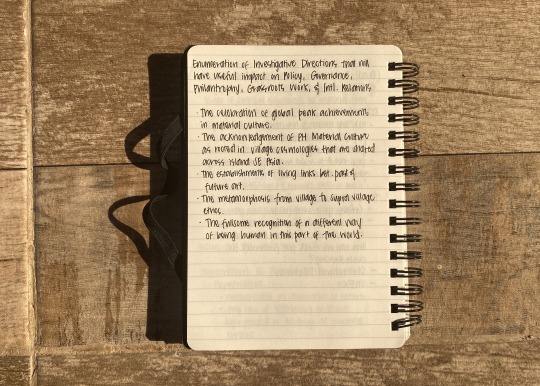
Enumeration of Investigative Directions that will have useful impact on Policy, Governance, Philantrophy, Grassroots Work, and International Relations, with regard to Philippine Material Culture
The celebration of global peak achievements in material culture.
The acknowledgement of Philippine Material Culture as rooted in village cosmologies that are shared across island Southeast Asia.
The establishments of living links between past and future art.
The metamorphosis from village to supra village ethos.
The fullsome recognition of a different way of being human in this part of the world.

#antiquities#culturalheritage#culture#literary theory#society#literature#art#history#museums#museum studies#provenance#repatriation#reMatriation
4 notes
·
View notes
Text
Those three vital lies are: (1) "Beauty" had to be defined as a legitimate and necessary qualification for a woman's rise in power. (2) The discriminatory purpose of vital lie number one had to be masked (especially in the United States, with its responsiveness to the rhetoric of equal access) by fitting it firmly within the American dream: "Beauty" can be earned by any woman through hard work and enterprise. Those two vital lies worked in tandem to let the use of the PBQ by employers masquerade as a valid test of the woman's merit and extension of her professional duties. (3) The working woman was told she had to think about “beauty" in a way that undermined, step for step, the way she had begun to think as a result of the successes of the women's movement. This last vital lie applied to individual women's lives the central rule of the myth: For every feminist action there is an equal and opposite beauty myth reaction. In the 1980s it was evident that as women became more important, beauty too became more important. The closer women come to power, the more physical self-consciousness and sacrifice are asked of them. "Beauty" becomes the condition for a woman to take the next step. You are now too rich. Therefore, you cannot be too thin.
The Beauty Myth: How Images of Beauty Are Used Against Women, by Naomi Wolf
#the beauty myth#naomi wolf#radblr#radfem#radical feminism#radical feminist safe#radical feminists do interact#radical feminists do touch#radical feminists please touch#feminism#feminist literature#radical feminists please interact#radical feminist literature#radical feminst#radical feminist theory#radical feminist community#misogyny#beauty culture#patriarchy
4 notes
·
View notes